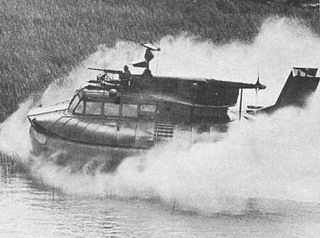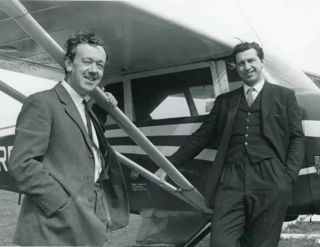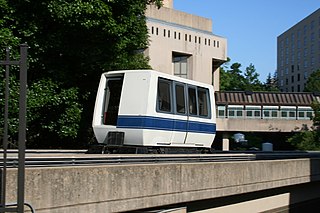Related Research Articles

A hovercraft, also known as an air-cushion vehicle or ACV, is an amphibious craft capable of travelling over land, water, mud, ice, and various other surfaces.

The SR.N4 hovercraft was a combined passenger and vehicle-carrying class of hovercraft. The type has the distinction of being the largest civil hovercraft to have ever been put into service.

Britten-Norman (BN) is a privately owned British aircraft manufacturer and aviation services provider. The company is the sole independent commercial aircraft producer in the United Kingdom.

The Bristol Proteus was the Bristol Engine Company's first mass-produced gas turbine engine design, a turboprop that delivered just over 4,000 hp (3,000 kW). The Proteus was a reverse-flow gas turbine. Because the second turbine drove no compressor stages, but only the propeller, this engine was classified as a free-turbine. It powered the Bristol Britannia airliner, small naval patrol craft, hovercraft and electrical generating sets. It was also used to power a land-speed record car, the Bluebird-Proteus CN7. After the merger of Bristol with Armstrong Siddeley the engine became the Bristol Siddeley Proteus, and later the Rolls-Royce Proteus. The Proteus was to have been superseded by the Bristol Orion which would have given a Britannia a 75% increase in power for cruising faster.
Saunders-Roe Limited, also known as Saro, was a British aero- and marine-engineering company based at Columbine Works, East Cowes, Isle of Wight.

The Britten-Norman BN-2 Islander is a British light utility aircraft and regional airliner designed and originally manufactured by Britten-Norman of the United Kingdom. Still in production, the Islander is one of the best-selling commercial aircraft types produced in Europe. Although designed in the 1960s, over 750 are still in service with commercial operators around the world. The aircraft is a light transport with over 30 military aviation operators around the world.

British Hovercraft Corporation (BHC) was a British hovercraft manufacturer that designed and produced multiple types of vehicles for both commercial and civil purposes.

A surface effect ship (SES) or sidewall hovercraft is a watercraft that has both an air cushion, like a hovercraft, and twin hulls, like a catamaran. When the air cushion is in use, a small portion of the twin hulls remains in the water. When the air cushion is turned off ("off-cushion" or "hull borne"), the full weight of the vessel is supported by the buoyancy of the twin hulls.
Hovertravel is a ferry company operating from Southsea, Portsmouth to Ryde, Isle of Wight, UK. It is the only passenger hovercraft company currently operating in the world since Hoverspeed stopped using its craft in favour of catamarans and subsequently ceased all ferry operations in 2005.
A personal hovercraft is a small hovercraft normally carrying fewer than 10 passengers. The low cost makes it affordable for personal use.

Griffon Hoverwork Ltd (GHL) is a British hovercraft designer and manufacturer.

A ground-effect vehicle (GEV), also called a wing-in-ground-effect (WIG), ground-effect craft, wingship, flarecraft or ekranoplan, is a vehicle that is able to move over the surface by gaining support from the reactions of the air against the surface of the earth or water. Typically, it is designed to glide over a level surface by making use of ground effect, the aerodynamic interaction between the moving wing and the surface below. Some models can operate over any flat area such as frozen lakes or flat plains similar to a hovercraft.

The Saunders-Roe SR.N6 hovercraft was essentially a larger version of the earlier SR.N5 series. It incorporated several features that resulted in the type becoming one of the most produced and commercially successful hovercraft designs in the world.

The British Hovercraft Corporation AP1-88 is a medium-size hovercraft. In a civil configuration, the hovercraft can seat a maximum of 101 passengers, while as a troop carrier, it can transport up to 90 troops. When operated as a military logistics vehicle, the AP1-88 can carry a pair of Land Rovers, a Bv202 tracked vehicle and trailer unit or up to roughly 10 tons (10,000 kg) of cargo.

The Griffon 2000 series is a light-weight hovercraft built in the United Kingdom by Griffon Hoverwork and used principally by military and rescue organisations.

The Saunders-Roe SR.N5 was a medium-sized hovercraft which first flew in 1964. It has the distinction of being the first production-built hovercraft in the world.

Nigel Desmond Norman, was an aircraft designer and aviation pioneer. Norman co-founded Britten-Norman in 1954, was appointed a Commander of the Order of the British Empire in 1970, and served as chairman and managing director of AeroNorTec (1988–2002). With his longtime friend and business partner John Britten, he also designed, built, and sailed racing yachts, as well as a series of air cushion vehicles and crop spraying equipment. He died of a heart attack at age 73 in 2002.

A hovertrain is a type of high-speed train that replaces conventional steel wheels with hovercraft lift pads, and the conventional railway bed with a paved road-like surface, known as the track or guideway. The concept aims to eliminate rolling resistance and allow very high performance, while also simplifying the infrastructure needed to lay new lines. Hovertrain is a generic term, and the vehicles are more commonly referred to by their project names where they were developed. In the UK they are known as tracked hovercraft, in the US they are tracked air-cushion vehicles. The first hovertrain was developed by Jean Bertin in the early 1960s in France, where they were marketed as the Aérotrain before being abandoned by the French government.
CCGS Penac was a Canadian Coast Guard AP1-88/100 air cushioned vehicle (ACV) or hovercraft and was based at CCG Hovercraft Base Richmond, British Columbia. The primary missions of Penac was search and rescue off the British Columbia Coast. The vessel was initially constructed in 1984 by the British Hovercraft Corporation for use as a passenger vessel in Copenhagen, Denmark as Lommen with Scandinavian Airlines and renamed Liv Viking just before the service began. Sold in 1997 after a bridge eliminated the vessel's need, the hovercraft was sold to Hovertravel for service on the Solent. However, the ACV never entered service and was acquired by the Canadian Coast Guard in 2004. Renamed Penac, the hovercraft remained in service until 2017.
The N.300 Naviplane was a French 30-ton multipurpose Air-cushion vehicle built by SEDAM for the Naviplane series of Aéroglisseur (Hovercraft).
References
- ↑ "SR.N2 Hovercraft". Flight. 1 July 1960. Archived from the original on 2009-09-26. Retrieved 2015-09-03– via Flightglobal Archive.
- ↑ Barton, Antony (26 November 2013). "Hovercraft of Cushioncraft Ltd". www.bartiesworld.co.uk. Archived from the original on 18 November 2020. Retrieved 2020-11-18.
- 1 2 "Cushioncraft". Flight . 24 June 1960. p. 868. Archived from the original on 25 September 2009. p 869,p870
- ↑ "Cushioncraft". Flight. flightglobal.com. 24 June 1960. p. 868. Archived from the original on 2018-01-19. Retrieved 2015-09-03.
- ↑ Keiller, I. L (1965). Performance and handling trials of britten-norman CC2-001 cushioncraft, XR 814. Farnborough: RAE. OCLC 1109562336.
- ↑ http://www.flightglobal.com/AIRSPACE/photos/hovercraftcutaways/images/13917/cushioncraft-cc4-cutaway.jpg [ dead link ]
- ↑ Miles, M; National Research Council of Canada Division of Mechanical Engineering (1969). Cushioncraft CC-7 performance trials, 2-4 June 1969. Ottawa, Canada: National Research Council Canada, Division of Mechanical Engineering. OCLC 61553820.